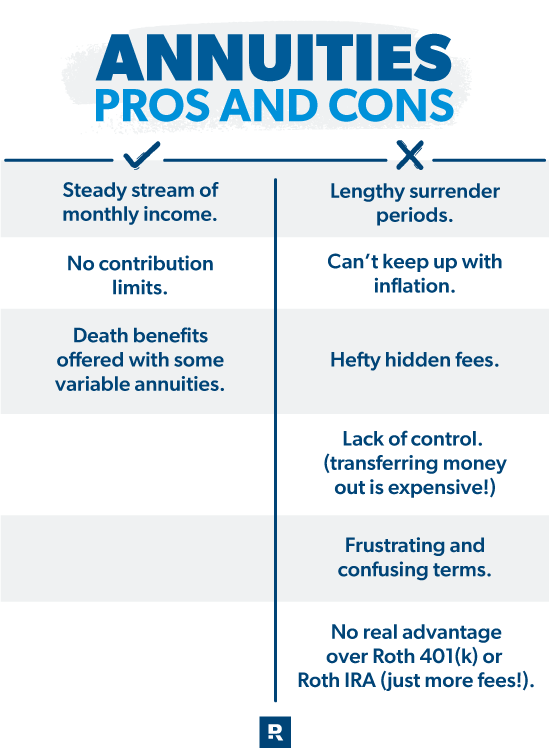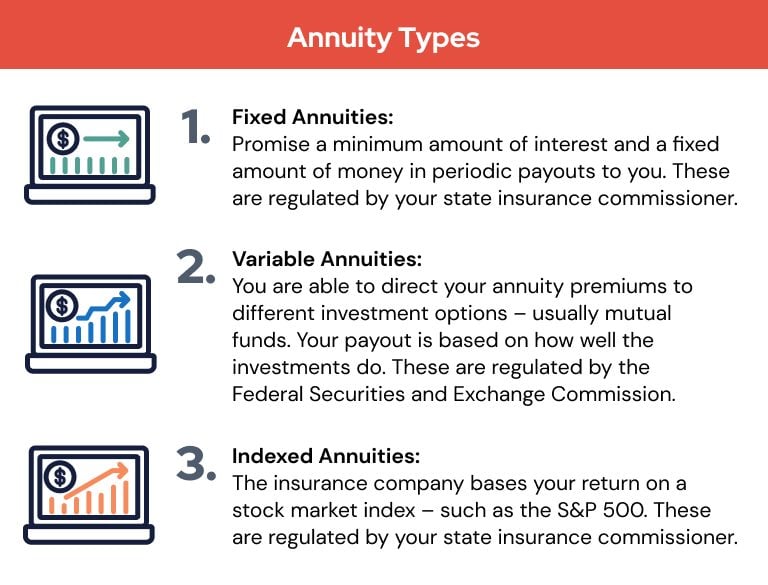All Categories
Featured
Table of Contents
Equally as with a dealt with annuity, the proprietor of a variable annuity pays an insurer a swelling amount or series of payments in exchange for the pledge of a collection of future repayments in return. As discussed over, while a repaired annuity grows at a guaranteed, continuous rate, a variable annuity grows at a variable price that depends upon the performance of the underlying financial investments, called sub-accounts.

Throughout the buildup phase, assets bought variable annuity sub-accounts expand on a tax-deferred basis and are exhausted only when the agreement proprietor withdraws those earnings from the account. After the accumulation stage comes the revenue phase. Gradually, variable annuity possessions ought to theoretically enhance in value until the agreement owner determines he or she would love to start withdrawing cash from the account.
The most considerable concern that variable annuities normally present is high cost. Variable annuities have a number of layers of fees and costs that can, in accumulation, create a drag of up to 3-4% of the contract's worth annually. Below are the most usual fees connected with variable annuities. This expenditure makes up the insurance company for the threat that it thinks under the regards to the contract.
Exploring the Basics of Retirement Options Key Insights on Your Financial Future What Is the Best Retirement Option? Benefits of Choosing the Right Financial Plan Why Choosing the Right Financial Strategy Matters for Retirement Planning How to Compare Different Investment Plans: A Complete Overview Key Differences Between Different Financial Strategies Understanding the Key Features of Long-Term Investments Who Should Consider Choosing Between Fixed Annuity And Variable Annuity? Tips for Choosing Fixed Income Annuity Vs Variable Growth Annuity FAQs About Planning Your Financial Future Common Mistakes to Avoid When Choosing a Financial Strategy Financial Planning Simplified: Understanding Fixed Income Annuity Vs Variable Growth Annuity A Beginner’s Guide to Variable Annuities Vs Fixed Annuities A Closer Look at Fixed Vs Variable Annuity Pros Cons
M&E cost fees are calculated as a percent of the agreement worth Annuity companies hand down recordkeeping and various other administrative costs to the contract proprietor. This can be in the type of a flat annual fee or a percent of the contract value. Administrative costs may be consisted of as component of the M&E threat charge or may be analyzed separately.
These costs can range from 0.1% for easy funds to 1.5% or even more for proactively handled funds. Annuity contracts can be personalized in a variety of means to serve the specific requirements of the agreement owner. Some common variable annuity riders include ensured minimum buildup advantage (GMAB), guaranteed minimum withdrawal benefit (GMWB), and guaranteed minimum earnings advantage (GMIB).

Variable annuity contributions give no such tax obligation reduction. Variable annuities often tend to be extremely ineffective vehicles for passing wealth to the future generation because they do not take pleasure in a cost-basis modification when the original contract owner dies. When the proprietor of a taxable financial investment account passes away, the price bases of the financial investments kept in the account are changed to reflect the marketplace prices of those investments at the time of the owner's death.
Analyzing Deferred Annuity Vs Variable Annuity A Comprehensive Guide to Investment Choices Defining the Right Financial Strategy Benefits of Fixed Income Annuity Vs Variable Annuity Why Variable Annuity Vs Fixed Indexed Annuity Is a Smart Choice How to Compare Different Investment Plans: Simplified Key Differences Between Different Financial Strategies Understanding the Rewards of Long-Term Investments Who Should Consider Variable Vs Fixed Annuities? Tips for Choosing Choosing Between Fixed Annuity And Variable Annuity FAQs About Planning Your Financial Future Common Mistakes to Avoid When Choosing a Financial Strategy Financial Planning Simplified: Understanding Your Options A Beginner’s Guide to Smart Investment Decisions A Closer Look at How to Build a Retirement Plan
Such is not the instance with variable annuities. Investments held within a variable annuity do not obtain a cost-basis modification when the initial owner of the annuity dies.
One substantial concern associated to variable annuities is the possibility for problems of passion that may exist on the component of annuity salespeople. Unlike an economic consultant, that has a fiduciary obligation to make investment decisions that profit the client, an insurance broker has no such fiduciary obligation. Annuity sales are highly rewarding for the insurance coverage professionals that market them due to the fact that of high ahead of time sales payments.

Many variable annuity agreements have language which places a cap on the percent of gain that can be experienced by particular sub-accounts. These caps protect against the annuity proprietor from totally participating in a section of gains that can otherwise be enjoyed in years in which markets produce substantial returns. From an outsider's perspective, it would seem that investors are trading a cap on financial investment returns for the previously mentioned assured flooring on financial investment returns.
As noted above, give up costs can seriously restrict an annuity owner's capacity to relocate properties out of an annuity in the early years of the contract. Further, while most variable annuities enable contract proprietors to withdraw a specified quantity throughout the accumulation phase, withdrawals yet quantity typically cause a company-imposed cost.
Withdrawals made from a set rate of interest investment choice might additionally experience a "market price adjustment" or MVA. An MVA adjusts the worth of the withdrawal to reflect any modifications in rates of interest from the moment that the cash was bought the fixed-rate choice to the time that it was withdrawn.

Frequently, also the salesmen who offer them do not fully understand how they work, therefore salespeople in some cases exploit a buyer's feelings to offer variable annuities instead of the advantages and suitability of the products themselves. We think that financiers should totally recognize what they own and exactly how much they are paying to possess it.
Decoding Variable Annuity Vs Fixed Indexed Annuity Everything You Need to Know About Financial Strategies Defining Retirement Income Fixed Vs Variable Annuity Pros and Cons of Various Financial Options Why Choosing the Right Financial Strategy Is a Smart Choice How to Compare Different Investment Plans: Simplified Key Differences Between Immediate Fixed Annuity Vs Variable Annuity Understanding the Risks of Long-Term Investments Who Should Consider Strategic Financial Planning? Tips for Choosing the Best Investment Strategy FAQs About Fixed Annuity Vs Variable Annuity Common Mistakes to Avoid When Planning Your Retirement Financial Planning Simplified: Understanding Choosing Between Fixed Annuity And Variable Annuity A Beginner’s Guide to Smart Investment Decisions A Closer Look at Fixed Income Annuity Vs Variable Growth Annuity
The exact same can not be stated for variable annuity properties held in fixed-rate investments. These assets lawfully come from the insurance provider and would for that reason go to danger if the business were to fail. Similarly, any kind of warranties that the insurance provider has agreed to supply, such as a guaranteed minimum income benefit, would be in inquiry in the occasion of a company failure.
Possible purchasers of variable annuities ought to comprehend and consider the monetary condition of the providing insurance coverage firm before getting in into an annuity agreement. While the advantages and disadvantages of numerous kinds of annuities can be questioned, the actual problem surrounding annuities is that of suitability.
Nevertheless, as the stating goes: "Caveat emptor!" This write-up is prepared by Pekin Hardy Strauss, Inc. Lifetime income from annuities. ("Pekin Hardy," dba Pekin Hardy Strauss Wide Range Management) for educational objectives only and is not intended as an offer or solicitation for business. The information and data in this post does not comprise lawful, tax obligation, accounting, financial investment, or other professional advice
Table of Contents
Latest Posts
Exploring Fixed Index Annuity Vs Variable Annuity A Closer Look at How Retirement Planning Works Defining What Is Variable Annuity Vs Fixed Annuity Advantages and Disadvantages of Variable Annuities V
Decoding Variable Annuity Vs Fixed Indexed Annuity Key Insights on Fixed Vs Variable Annuity Pros Cons What Is Annuities Variable Vs Fixed? Benefits of Variable Vs Fixed Annuity Why Variable Annuity V
Breaking Down Variable Annuity Vs Fixed Annuity A Closer Look at Pros And Cons Of Fixed Annuity And Variable Annuity What Is Indexed Annuity Vs Fixed Annuity? Pros and Cons of Fixed Interest Annuity V
More
Latest Posts